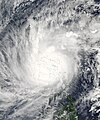Fichier:Durian 2006-11-30 0500Z.jpg

Taille de cet aperçu : 457 × 599 pixels. Autres résolutions : 183 × 240 pixels | 366 × 480 pixels | 586 × 768 pixels | 781 × 1 024 pixels | 1 563 × 2 048 pixels | 5 800 × 7 600 pixels.
Fichier d’origine (5 800 × 7 600 pixels, taille du fichier : 6,18 Mio, type MIME : image/jpeg)
Historique du fichier
Cliquer sur une date et heure pour voir le fichier tel qu'il était à ce moment-là.
| Date et heure | Vignette | Dimensions | Utilisateur | Commentaire | |
|---|---|---|---|---|---|
| actuel | 11 décembre 2006 à 03:29 |  | 5 800 × 7 600 (6,18 Mio) | Coredesat | |
| 11 décembre 2006 à 03:25 |  | 5 000 × 6 500 (11,94 Mio) | Coredesat | ||
| 11 décembre 2006 à 03:11 |  | 5 000 × 6 000 (5,12 Mio) | Coredesat | {{Information |Description=NASA MODIS image of Typhoon Durian over the Bicol Region of the Philippines, on November 30, 2006. |Source=[http://earthobservatory.nasa.gov/NaturalHazards/shownh.php3?img_id=13996 NASA Ea |
Utilisation du fichier
La page suivante utilise ce fichier :
Usage global du fichier
Les autres wikis suivants utilisent ce fichier :
- Utilisation sur de.wikipedia.org
- Utilisation sur en.wikipedia.org
- Utilisation sur nl.wikipedia.org
- Utilisation sur sv.wikipedia.org
- Utilisation sur th.wikipedia.org
- Utilisation sur tl.wikipedia.org


